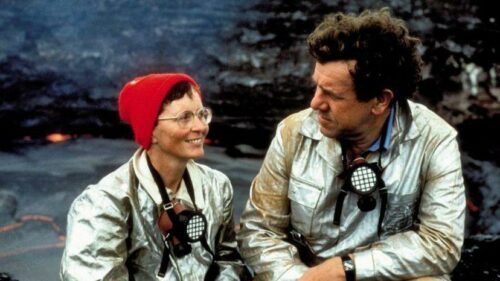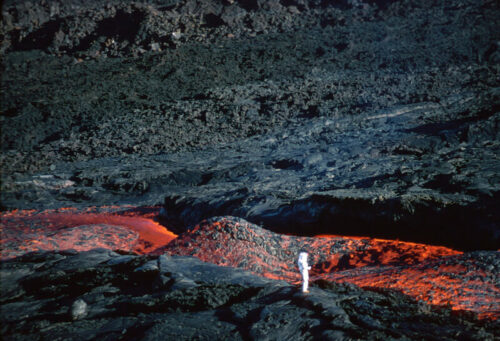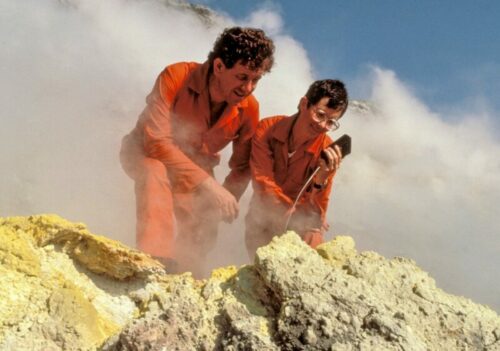An American Werewolf in London vs. The Howling, Armageddon vs. Deep Impact, Platoon vs. Full Metal Jacket, Help! vs. Head, Freddy vs. Jason vs. Alien vs. Predator…. With there being so very few ideas for movies available to the AI chatbots that have, let’s be honest, been writing Hollywood screenplays for over 50 years now, it’s no wonder that the same movies are not only made over and over again, but are released in the same year, such that they must grapple like sweaty, mustachioed wrestlers of yore for our attention, dollars, and accolades. Should we be surprised, then, that the austere world of documentaries has fallen victim to the same forces? No, the only surprise is that it’s taken so long (or then again, has it? There were those two Woodstock ’99 docs, and those two docs about the musical festival that never even happened, and, oh, okay, probably a hundred more).
In any case, this past year saw two documentaries made about the same (and, surely, only) famous French volcanologist couple, Katie and Maurice Krafft. The Fire Within: A Requiem for Katie and Maurice Krafft is by Werner Herzog, and is no doubt inspired by his previous volcano documentary, Into the Inferno (’16), which featured a handful of memorable clips shot by the Kraffts (and is, btw, if you’ve not seen it, excellent and highly recommended). Fire of Love is by Sara Dosa, and though I have no idea why she chose to make a documentary about this couple, I’m going to assume it’s because she saw Into the Inferno and thought, Say, those two would make an interesting subject for a movie.

And indeed they would. Would they, however, make an interesting subject for two movies? Or could one watch a single doc about them and be satisfied? And if so, which one? Or does it even matter which?
The answers are: Not so much, almost certainly, I’m getting to that, and yes.
Let’s start with Herzog. Summing up his film is easy: It’s fantastic. Why wouldn’t it be? He’s Werner Herzog. He’s been making genius documentaries for fifty years. His docs are like nobody else’s. He injects them with his unique personality, his deep fascination with humanity, and his deep love of individual humans. He is, as he’s often pointed out, not interested in the accountant’s truth, but in poetic truth. His goal is not to present documentaries as some kind of above-it-all objective artifacts, but to openly inject himself, his opinions, his theories, his beliefs into them, for the simple reason that this is unavoidable, and, if embraced, results in movies full of passion and yearning and love.
In the case of the Kraffts, Herzog does what he did with Grizzly Man: He uses only the film shot by his subject(s). And the Kraffts left plenty of material, hundreds and hundreds of hours of film. They filmed everything, everywhere they went. Their footage of volcanoes is spectacular, otherwordly, hypnotic, and there’s plenty of it in The Fire Within, often presented as Herzog has done in the past, with no narration, only music, such that as a viewer we’re drawn in and held, mesmerized, as bright orange molten rock swirls and bubbles and spits and splashes.

The story Herzog chooses to tell isn’t exactly biographical, though the movie charts a mostly chronological course. It’s more that he’s decided not only to use the Kraffts’ film as his film’s only visuals, but to tell us their story based only on what and how they shot what they shot. Herzog approaches the Kraffts, then, as fellow filmmakers, a breed of human with whom he’s intimately familiar. He’s fascinated by what they choose to shoot, and how those choices change over the course of their lives. His narration explores what he thinks that suggests about who they are and how they grew as people and as a couple. And it’s fascinating. As always, with Herzog. Is he “right” about who they were? Who’s to say but the Kraffts? And they’re not (spoiler) alive to tell us. What Herzog is is deeply intuitive. By the end of the movie, I felt I knew these people. Not in the way I know a close friend, not in so personal a way. But in some kind of poetic, human sense. Maybe it’s that I wound up with a feel for these people.
And the visuals. Yowza! The Kraffts had a knack for filming volcanoes, as you’d expect. And Herzog has a knack for choosing images, for editing, for knowing what to linger on, and when to shut up and just let us watch.
The best thing about Fire of Love, especially if one has already watched The Fire Within, is that, with hundreds of hours of film to choose from, Dosa chose many different clips than Herzog did, and they’re all equally marvelous. There’s just no shortage of images shot by the Kraffts. Unfortunately, Fire of Love is, otherwise, a documentary like any other modern documentary, thus the Kraffts’ images aren’t enough. We also get some twee animated segments, because what would a modern documentary be without animated sequences?
Speaking of twee, my goodness but this flicks leans into it, and hard. Watching it, one might suspect Dosa’s lone filmmaking inspiration is Wes Anderson. We get cute little boxes of images side by side, cute old-timey French songs along with the occasional left-field Brian Eno track, or what have you, and to top it all off, narration spoken by Miranda July, whose voice could be no more twee. There is, therefore, a certain degree of insufferability to the movie.
Not helping the voice July speaks in are the words she’s speaking. Fire of Love is billed as a love story, yet the narration plays as a string of trite banalities about love one could apply to any couple. The movie lacks insight. The only moments where we actually come to know these specific individuals are when they’re the ones talking, in old interviews clips. Whenever the narration kicks in, we’re back to greeting-card level platitudes and bad love poetry.
One might guess, therefore, which of these two movies was nominated for an Oscar.
If you’re going to watch only one movie on the world’s only famous volcanologist couple, Herzog’s The Fire Within is the way to go. If you’re yet burning for still more footage of and by the Kraffts, Fire of Love has you covered, but be sure to don your twee-proof earmuffs first, or illness may result.


How do they compare to Joe vs. the Volcano, though? It’s hard to imagine a better documentary than that.